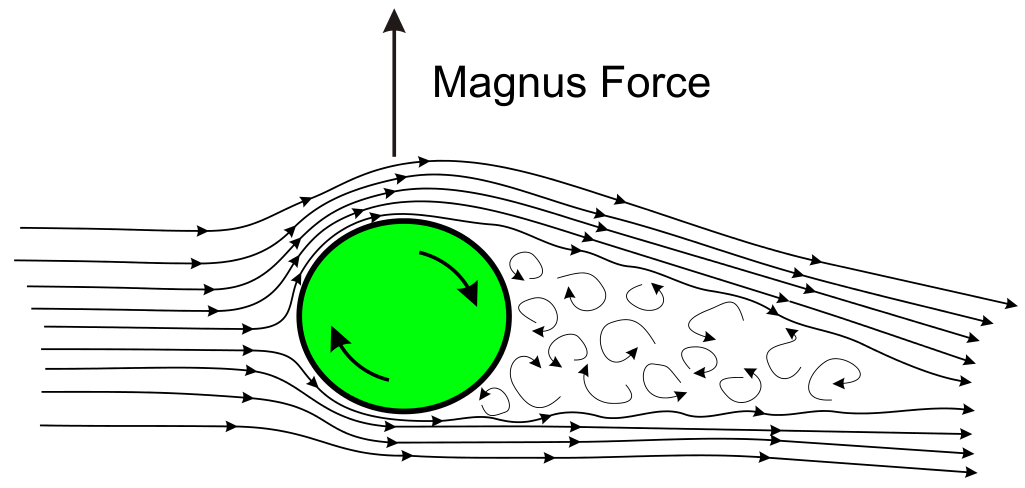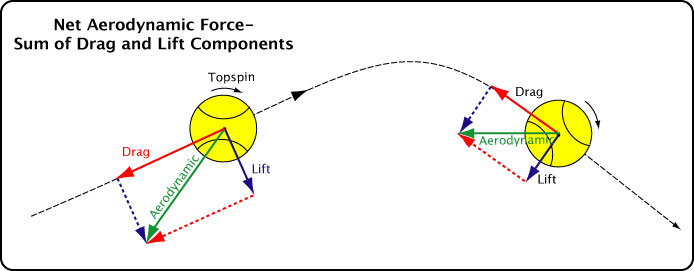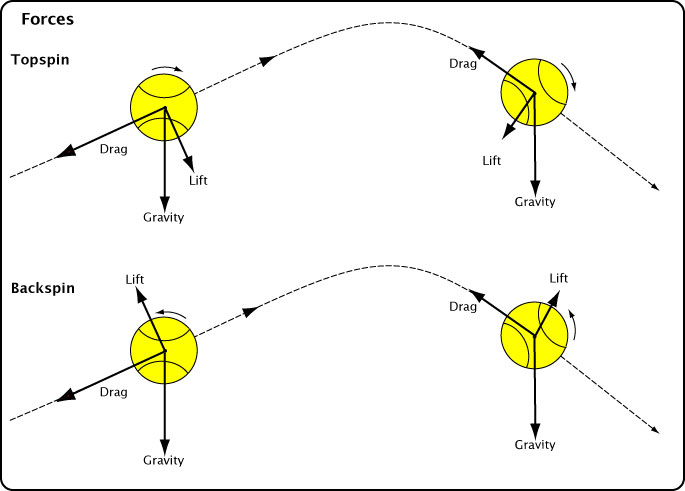Ball Spin In Flight
When a ball is
hit in tennis, spin is often imparted on it to
affect its trajectory and bounce. The three most
common ways to hit a tennis ball are flat (no
spin), with topspin, or sliced (hit with
underspin/backspin). The type of spin put on the
ball affects its trajectory in the air, as well as
how it bounces. We will will cover the effects and
physics of these three types of spin. For our
explanations, we will identify rotational motion
of a tennis ball in the direction of topspin a
forward rotation/spin, and rotational motion in
the direction of underspin as backward
rotation/spin. First, however, we must cover the
Magnus effect, which is what causes the
differences in movement behavior during flight of
the balls undergoing different spins.
Magnus Effect:

The Magnus
Effect is a physical phenomenon that imparts an
additional force on a spinning object. The
spinning of a ball causes the drag forces at the
top and bottom of the ball to be unequal. In the
case of backspin (pictured), the drag at the
bottom of the ball is greater than at the top of
the ball because the tangential velocity of the
bottom of the ball is in the same direction as the
velocity of the ball's trajectory. This means the
bottom of the ball has a greater magnitude
velocity relative to air around it than the rest
of the ball, which results an increased drag
force. it Similarly, the drag at the top of the
ball is reduced since the top of the ball has a
lower velocity relative to the air around it than
the rest of the ball. These drag forces can be
thought of as exerting a unequal pressure on the
ball, with greater drag corresponding to greater
pressure. The resulting pressure differential then
causes a net force on the ball in the direction of
the low pressure. In the case of backspin this
results in an upward force on the ball, and for
topspin this results in a downward force on the
ball. This is similar to how an airfoil generates
lift.
Img Src:
http://en.wikipedia.org/wiki/Magnus_effect
Source: [2]
Flat Hit:
A ball hit with no spin, also
known as a flat hit, does not rotate with any
significant angular velocity as it flies through
the air. Thus it does not experience a Magnus
force. The ball does however experience an
ordinary drag force that acts in the direction
opposite of its velocity. As noted on the previous
page, the magnitude of the drag force on an object
is given by
.
The trajectory of a flat shot can thus be
approximated numerically using the equations for
the horizontal and vertical accelerations of a
small projectile experiencing drag:
where
is the drag
coefficient,
is the density of air,
is cross-section area of the object,
is the mass of the object,
is the acceleration of gravity, and
and
are the horizontal and vertical velocities of the
project respectively. Unlike projectile motion in
a vacuum, the horizontal and vertical components
of acceleration are not independent of each other
since
depends on
and vice-versa.
Source: [3]
Img Src:
https://www.linkedin.com/today/post/article/20140920022202-82311677-virtual-tennis-academy-lesson-1-slice-topspin-in-tennis
Topspin:

Img Src:
http://twu.tennis-warehouse.com/learning_center/aerodynamics2.php
To hit a ball with topspin, a
player rotates the head of the racquet over the
top of the ball during the hit. This exerts a
torque about the center of the ball that causes
the ball to rotate with a forward spin during its
flight. As the diagram above shows, topspin is
characterized by the tangential velocity of the
top of the ball pointing in the same direction as
the trajectory of the ball.
Hitting a ball with topspin
causes a Magnus force to act on the ball
perpendicular to the velocity of the ball in the
downward direction. Because there is an additional
downward force on the ball, tennis players can hit
the ball with a greater speed and have it land in
the court, if they apply topspin to the ball when
hitting it. In addition, balls can be hit higher
above the net, making the shot more difficult to
return, because the addition downward force pulls
the ball downwards. This also results in a higher
bounce for the ball.
Source: [1]

Img Src:
http://twu.tennis-warehouse.com/learning_center/aerodynamics2.php
Underspin (Backspin):
To hit a
ball with underspin, or backspin, a player
angles his racquet back and slides it underneath
the ball when hitting it. This type of shot is
called a slice. It exerts a torque about the
center of the ball that causes the ball to
rotate with a backward spin during its flight.
As the diagram above shows, underspin is
characterized by the tangential velocity of the
top of the ball pointing in the opposite
direction as the trajectory of the ball.
Hitting a ball with topspin
causes a Magnus force to act on the ball
perpendicular to the velocity of the ball in the
upward direction. Because there is an additional
upward force on the ball, the ball seems to
"float" through the air as it flies. Slice shots
are thus generally hit low over then net and
with a relatively slow speed, in order to keep
them from going out of the bounds of the court.
This results in the lower bounce for the ball.
In addition, slicing the ball allows the player
to hit the ball to a precise location in the
opponents court. However, due to the way slice
shots are hit, if a player attempts to slice a
ball that is moving to fast, or hit a slice shot
too hard, he or she can easily hit the ball out
of bounds.
Source: [1]

Img Src:
http://twu.tennis-warehouse.com/learning_center/aerodynamics2.php